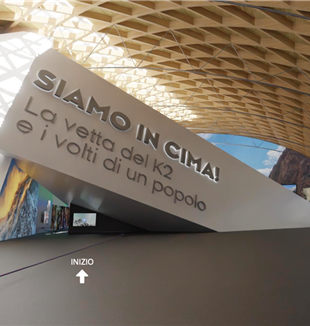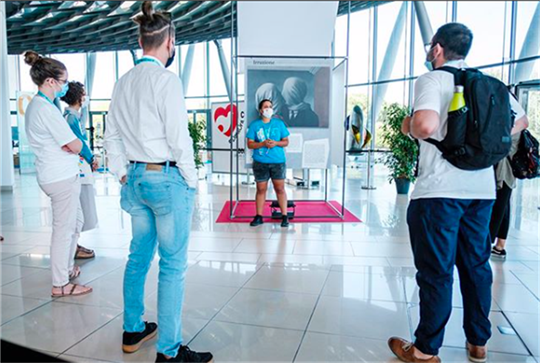
Meeting 2020 exhibitions: vaccinated against doubt
The audacity of wonder, from Giussani's questions to an expedition at eight thousand meters. The Meeting's four exhibitions and the ways to see them, both physically and at a distance, or only in a digital format.The unexpected shapes the face of those who see it, suddenly the face lights up with surprise. "But who is surprised by the usual, the ordinary? We should always live as though we have escaped to taste everything with gratitude." The video of the exhibition "Living the reality" is made from images and words that are like "a review of the existence of things." The spectacle of nature, of man, of light - in a word, of creation, of which we have lost confidence.
The film, which can be watched on the Meeting’s website, is the heart of the exhibition now at the Palacongressi, which can be more deeply understood with the help of virtual dialogues (webinars that can be booked online) and which is a path through the pages of the 10th chapter of Fr. Giussani’s Religious Sense and Julián Carrón’s Reawakening Our Humanity, among literary quotations, from Chesterton to Ungaretti to Gozzano, from film clips, photos and art images, like Yayoi Kusama’s polka dot pumpkin.
The exhibition was born from the desire to question the Meeting’s title, the phrase by Abraham Heschel, and the context from which it is taken, The Religious Sense, in an outcome curated by Professor Carmine Di Martino together with about a hundred university students. "But we immediately clashed with the explosion of the pandemic," says Luna, a young Muslim, who is now a volunteer at the Meeting for guided tours. Rather than explaining, she throws questions and provocations at visitors, sharing what she has experienced in recent months, when "we went ahead distracted and the virus took us away from the obvious. Reality took over the scene." Then she quotes a verse from the Quran, in which "God says to man: I could have not made you and I did make you" and, in the path amongst the panels, everything - from heaven to one's own breath - is offered as great, gigantic, it may not be there, but it is there. "Only from this wonder are the questions of reason reborn". Why is everything there? Why? Where does it come from? What about me? Who am I? Where am I going?
"The 10th chapter of The Religious Sense is not about imagination. We come to think that Giussani - when he explains how the ultimate questions are posed - is a poet. No!", said Carrón in the webinar dedicated to the exhibition, on the first day of Meeting: "He speaks of a real experience, which happens. As someone, for example, who wakes up from a coma tells us…But a real gaze towards reality is not an experience that happens once and for all. It is not mechanical. A moment later I can fall back into the obvious and I find myself faced with an option: where do I look?" Urged by the questions of the many who follow the Meeting from their homes and cities, in Italy and abroad, he reversed the question: "We know all these things about wonder! But when has it happened to us? When was the last time we were surprised like this? The possibility given to us is that Giussani’s manner of being surprised become familiar to us: not as a logic, not as a culture, but as an experience of living." And he talked about the need for a path: "The moment of the miracle is not enough. What do we need? A daily, familiar presence. That is what God does with us. What has He given us to help us wonder? He became flesh, to the point of giving us a companionship of men capable of this amazement: following them, in time, with patience, their way of looking becomes ours.”
The Meeting proposes another physical exhibition, the one on the Basilica of Bethlehem: "Bethlehem reborn. Nativity’s wonders". According to the curator, Mariella Carlotti, it is a challenge to break our relationship with reality, because it is dedicated "to the place "of reality" par excellence: the place where God became human reality." A place restored in its exceptionality by an epochal restoration (the first complete one in seven centuries), which began in 2013 and ended last December 6. Throughout the exhibition - which develops in parallel between the exhibition at the Palacongressi and the virtual contents - the focus is not on the restoration, but on the Basilica, which we can now see as no living person has ever been able to see: the story of the oldest monument in Christendom winds through history, politics, art, but also through the voice of pilgrims, the experience of devotion over the centuries.
UNESCO wanted this exhibition, which will in fact tour to Paris, but which was born in Rimini from a story of friendship which had brought an exhibition on the restoration work to the 2016 Meeting. This year's exhibition was curated by Carlotti, together with a director from Prato, Tommaso Santi, archaeologist Alessandro Fichera and Taisir Masrieh Hasbun, set designer, publisher and cultural attaché at the Palestinian Embassy to the Holy See. "We worked for four months without ever seeing each other in person because of the pandemic. We thought it was impossible for the exhibition come to come alive, instead we overcame difficulties that seemed insurmountable to us. And that is what I hope will happen to our country."
"When you get to the top with someone, you are stuck with them your whole life." The summit is K2, to which the exhibition "We're on the top!" is dedicated. (in digital format only), which tells the story of the 2014 expedition and is curated by two of its protagonists: Michele Cucchi and Agostino Da Polenza. A two-month climb of almost nine thousand meters, to the conquest of the second highest peak in the world after Everest. "The most intimate moment? I think when it appeared!", says Cucchi: "Pure respect! Of little men who let themselves be welcomed in a huge glacial basin in the presence of His Majesty!" He accepted to participate because of the value that this expedition, which paid homage to the immense enterprise sixty years before, had for the Pakistani people: it was July 31, 1954 when Achille Compagnoni and Lino Lacedecelli first conquered what adopted the name "mountain of the Italians". It was the meeting between some friends of the Meeting with Cucchi and Da Polenza that gave rise to the idea of recounting the challenges that the mountain poses to man: "It is not only climbing high, but also looking at the other, and taking them with you." Audio, extraordinary videos and webinars with the protagonists and curators give the chance to relive the efforts and passion born from the attraction that pushed them up there, willing to do anything.
The echo of this attraction resonates in the words of Konrad Lorenz, founder of modern ethology, in what is a sort of motto of the last exhibition of the Meeting: "Living Being", curated by Euresis and Camplus (in digital format only). Lorenz writes: "Truth is not only beautiful, but it is full of mystery and you do not need to give yourself to mysticism to live wonderful adventures. Every person who rejoices at the sight of living creation and its beauty is vaccinated against the doubt that all this can be meaningless." The exhibition is divided into four virtual corners and four video-interviews which, through the enormous developments in the biological sciences over the last few decades, open our eyes wide to the profound nature of every living being, which is "a relationship with something other than oneself" and the extraordinary complexity and creativity of life that pervades our planet. Codes, signs, chemical acrobatics, dependence on the world, evolutionary dynamics, DNA, immutable laws and unpredictability... The exhibition is the discovery of the surprising logic that, as one of the curators, Professor of Biochemistry Giorgio Dieci, explained, "unites all living things: from the unicellular bacterium to the variety of animal and plant species that populate the waters and the earth, up to man. Up to each one of us."#Meeting20